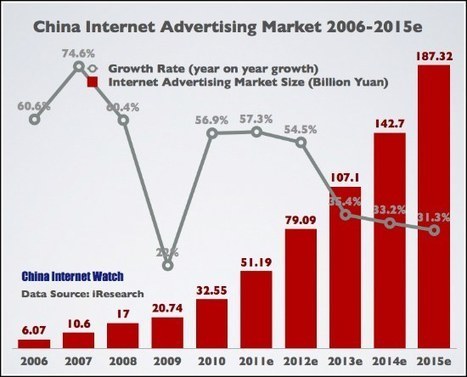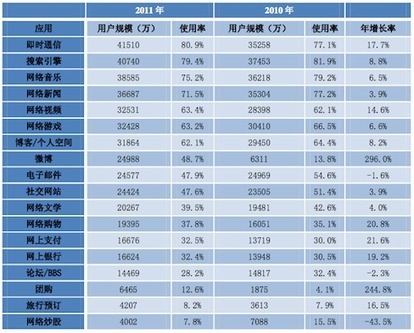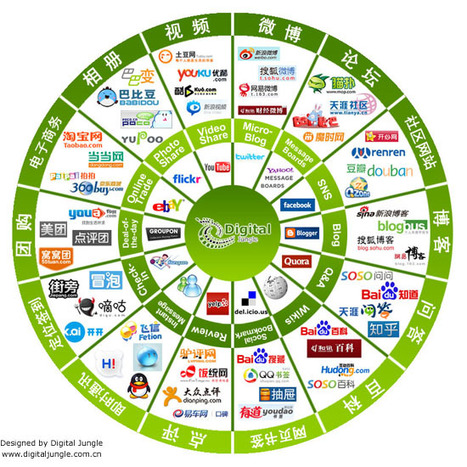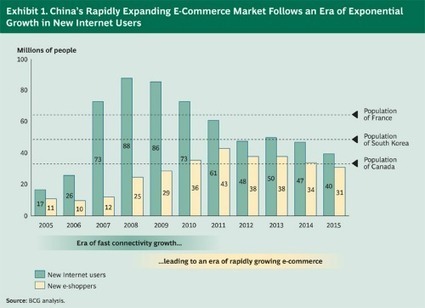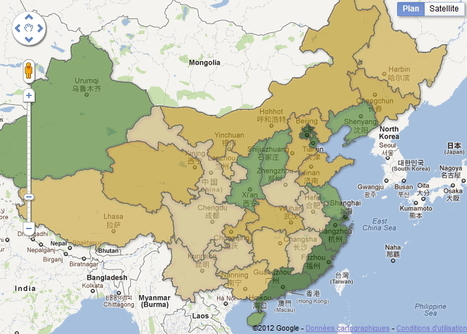 Your new post is loading...
 Your new post is loading...

|
Scooped by
173 Sud
January 19, 2012 12:18 PM
|
China B2C market generated US$ 38 billion (RMB 240 billion) in sales in last year, up 131% from the same period a year ago, according to a report by Beijing-based market researcher AnalysysInternational. For the last quarter of 2011, the transaction volume reached 12 billion across the market.

|
Scooped by
173 Sud
January 19, 2012 12:01 PM
|
China internet advertising total revenue reached 51.19 billion yuan (USD 8.11 billion) in 2011, up 57.3% from 2010 and exceeding total newspaper ad revenue by 45.36 billion yuan.

|
Scooped by
173 Sud
January 18, 2012 11:34 AM
|
China will expand real-name registration for microblog users, a senior propaganda official has said. Authorities have grown increasingly concerned about the speed with which information and allegations can spread on the Twitter-like services, which have more than 300m registered users in China. Last month, the Beijing municipal government said users would have three months to register their real identities or face the consequences. "Currently, this type of registration is being tested in Beijing, Shanghai, Tianjin, Guangzhou, and Shenzhen. We will extend it to other areas once the pilot programmes prove successful," said Wang Chen, minister of the State Council Information Office. "We will focus on newly registering users and then extend it to existing microbloggers." He added: "Microblogging is a new medium that can spread information rapidly and have a big influence. It covers a wide population and can mobilise people." He said the growth of services had been "explosive" and that microblogs could help officials to understand the social situation and public opinion, spread positive opinion and improve their information services. Authorities were committed to becoming more open and had launched their own accounts. But he warned that while authorities welcomed the benefits of new media, "We also need to control the spread of rumours undermining social stability; harmful, for example pornographic, information; and illegal conduct for commercial purposes."

|
Scooped by
173 Sud
January 17, 2012 4:09 PM
|
Wang Xing was 26 years old and already the founder of a failed Chinese takeoff of oncehot Friendster when he cloned Facebook. It was December 2005 in Beijing, and Wang and two friends had made an excellent copy. Xiaonei would quickly become the most trafficked Chinese version of Facebook, but less than a year in, forced to borrow money from his parents to keep it going, Wang sold his first success for several million dollars. He and other friends next copied Twitter. Fanfou would become China's highest-profile Twitter clone, but it was taken off line by the government after the Xinjiang riots of July 2009 and would not return for more than a year. Meanwhile Xiaonei flourished under its new owners and its new name, Renren; it will soon be valued at more than $4 billion in a highly anticipated U.S. IPO. Copying Western Internet businesses is an oft-beaten path to success in China, where the large customer base, the language barrier and political obstacles for foreigners make it a promising market for domestic players. Groupon is especially conducive to cloning because it generates cash flow from day one, and the Chinese market already had experience with group-buying specials long before Groupon started in the U.S. But the Chinese market also loves to replicate potentially profitable businesses, both offline and online, until competition threatens to bury the whole lot. This leaves stand-alone sites vulnerable to profitable Internet conglomerates like Tencent and Alibaba Group.

|
Scooped by
173 Sud
January 17, 2012 3:45 PM
|
China now has more than 513 million Internet users and over 356 million mobile Internet users by the end of December, 2011, according to the 29th Statistical Report on Internet Development out today by CNNIC, or China Internet Network Information Center, the state-run network information center of China. Highlights *By year-end of 2011, over 513 million Internet users (increased by 55.8 million in last year) and 356 million mobile Internet users (increased by 52.85 million) in China *Out of all the netizens, 73.4% of them are equipped with desktops while 69.3% use mobile devices *More than 2.3 million websites in China *More than half Chinese Internet users (48.7%) are using weibos, gaining on traditional news channels as weibos now serve as one of the major news sources *Entertainment applications facing downturn, whereas online video rises steadily with more than 325 million users, or a use rate of nearly 63.4% *Ecommerce sees growing in general including online shopping (increased by 33.44 million, or 20.8%), online payment (up 32.5%) and online banking (up 32.4%) The report also shows that in the past year more than 64.65 million users purchased on Chinese group buying sites.

|
Scooped by
173 Sud
January 17, 2012 4:04 PM
|
The social media platforms within the Chinese and Western webs continue to evolve and change. When I look back at the chart I made a few years ago that outlined what Chinese sites participated in the social media space I notice many have disappeared, changed their focus or go on to absorb others in that sector. So for 2011, I have put together a new image outlining the Chinese social platforms against a Western counterpart (for camparison). Also, for those marketers that are not familiar with the sites, I have put together a list of URL's that provide an easy to find link to the various sites. (Thanks to Celine - our Marketing Intern for putting the URL list together).
|

|
Scooped by
173 Sud
January 19, 2012 12:06 PM
|
BCG forecasts that e-commerce will go from representing 3.3 percent of total retail value today to 7.4 percent in 2015. Find out more insights. Boston Consulting Group shared research findings this week predicting that China online shopping, will see exponential growth through 2015, with spending that could make China’s e-commerce market worth more than RMB 2 trillion and possibly surpass the size of the U.S. market. Here is a summary of some findings of BCG survey: + Less than 10 percent of China’s urban population shopped online in 2006. The figure jumped to 23 percent in 2010 and will nearly double to 44 percent by 2015. + An astonishing 30 million additional Chinese consumers are expected to shop online for the first time every year until 2015. + E-commerce in China will go from representing 3.3 percent of the country’s total retail value today to 7.4 percent in 2015. It took the United States ten years to achieve that growth. + Within five years, most of today’s online shoppers in China will be spending RMB 6,220 (or about $980) per year, twice what they are today. That’s close to the U.S. average of $1,000. +The low cost of shipping in China gives e-commerce an ongoing boost. It costs $1 on average to ship a 1-kilogram parcel, versus $6 in the U.S.

|
Scooped by
173 Sud
January 19, 2012 10:13 AM
|
Three top Chinese tech companies--Alibaba, Baidu, and YouKu--are remaking the country's moribund, hierarchical corporate culture with an injection of new ideas from the West. Since corporations began popping up here during the economic liberalization of the 1980s, workplace culture has been defined by what one might call the Great Wall of corporate China--a divide between the haves (the executives) and the have-nots (the workers). Consider the state-run drug company Harbin Pharmaceutical Group, whose particularly opulent Sixth Factory in Harbin, in China's far northeast, drew the attention of state broadcaster CCTV in September. The corridors boast walls inlaid with gold leaf. Crystal chandeliers descend from the ceilings. The furniture looks straight out of Versailles (though it would insult the dead to imply workmanship worthy of the name Louis XIV). From these luxe digs, the fat cats, Communist Party members all, supervise their charges--without seeing them, if possible. Now the old ways are under attack. With the Communist authorities increasingly aware of the nation's social divisions and potential restiveness, news-media coverage of Sixth Factory-like excess has grown. And as China has opened up to the West, practices from abroad have crept into corporate life nowhere more quickly than in the Internet sector. Leaders such as Ma have been inspired by the examples of Silicon Valley tech titans. Another new cohort of Chinese executive--educated and professionally seasoned in the U.S.--is returning home with new thinking about management and work, including a more in-the-trenches ethos, a heightened appetite for risk, and a different understanding of innovation. Those execs have earned a well-known nickname: haigui, or sea turtle, which in Mandarin is homonymous with the word for a person who goes overseas and then returns home to China.

|
Scooped by
173 Sud
January 18, 2012 10:53 AM
|
For people outside China, they wonder why Chinese love to copy things. After being here a while, most people figure out, it’s the way they were taught to learn. Follow the teacher, recite books, don’t challenge. This mentality grows and sticks with people as they mature. Moreover, I’m sure many start-ups think, “Why shouldn’t I copy?” If the business model has been proven overseas and they know how to adapt it to China, then by not copying, it almost represents a missed opportunity. When I interviewed the co-founder of Match.com, Peng Ong (now a Partner at GSR Ventures) he said “Copying is a form of innovation. The best company’s never just copy, they copy and then localize. It’s like jazz, you have a basic rhythm and structure and you move around that. Is jazz copying? I don’t think there is any original idea. Google is a copy.” I’ve realized that the term ‘Innovation’ can be interpreted in many ways. In China, I feel it means ‘to adapt and improve’, which is still a valid interpretation. To some degree everyone learns by copying, babies do it, adults do it. But where it becomes a touchy subject, is when Chinese clones don’t just copy the business model, they copy everything except the logo! The winning place is based on having a market leader position in the market perception. Of course all the original start-ups that made it big, originate from America, particularly the Silicon Valley.

|
Scooped by
173 Sud
January 17, 2012 4:00 PM
|
Here’s Hongyi Zhou’s advice to Chinese entrepreneurs: “Don’t try to be cool.” Zhou is CEO of Qihoo 360 (NYSE: QIHU), whose company’s core is the definition of uncool: anti-virus software. Yet Qihoo has 370 million monthly active users and a very cool $1.9 billion dollar valuation. If you want to build a big company in China, don’t build for your iPhone-toting friends, the Chinese tech blogs, or copy the latest fad on TechCrunch. Chinese entrepreneurs must appreciate the vast chasm between white-collar elites and the rest of the country. The Silicon Valley has an echo chamber of its own, but China’s is an order of magnitude louder. “There’s only 80 million or so white-collars in China, and not even 5 million could be considered your peers,” Zhou told a group of Chinese Stanford students visiting as part of the Stanford CEO Beijing tour over winter break. Many of the students are already running startups in China or considering returning to do so. Hot startups that pop up on TechCrunch all have at least five Chinese versions. That’s a common route for the ‘cool kids’ among Zhongguancun’s techies: there are more Tumblr, Flipboard, Pinterest, Instagram, and WhatsApp clones and mashups than you can count. You may receive a mention on 36kr or Tech2IPO, China’s top startup blogs, but that does nothing for your user growth in a second-tier Chinese city, let alone in the third, fourth, or fifth tier.

|
Scooped by
173 Sud
January 17, 2012 3:37 PM
|
After CNNIC released its 2012 report on internet use in China, one of the key datasets that I was eager to look at was internet penetration by province. Here it is on a map. Areas in green are above the national average of 38.3 percent, while areas in yellow are below the average. As you might expect, areas along the east coast, as well as the capital Beijing have pretty high penetration rates – Beijing being the highest at 70.3 percent. I have to admit though that I was a little surprised to see Xinjiang province in the west ranks ninth in the country in internet penetration at 40.4 percent, just above the national average. What about Hong Kong and Taiwan you ask? Well, CNNIC didn’t include them for some reason — which is interesting. But FYI, according to Internet World Stats Hong Kong and Taiwan are way up there with 68.8 and 70.1 percent respectively.
|



 Your new post is loading...
Your new post is loading...



